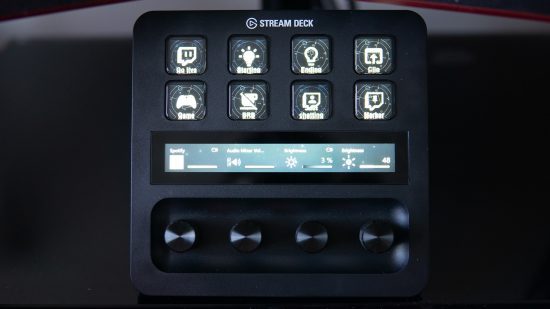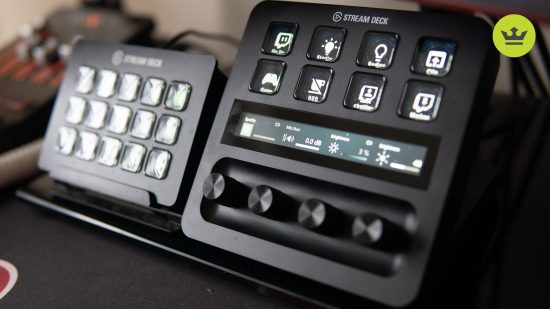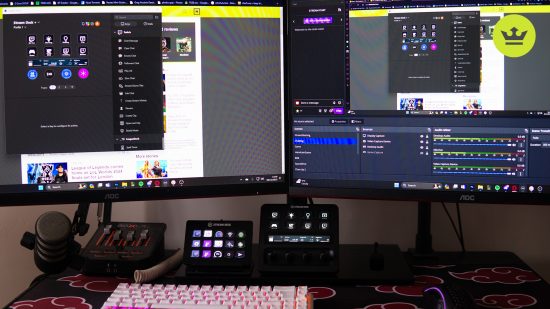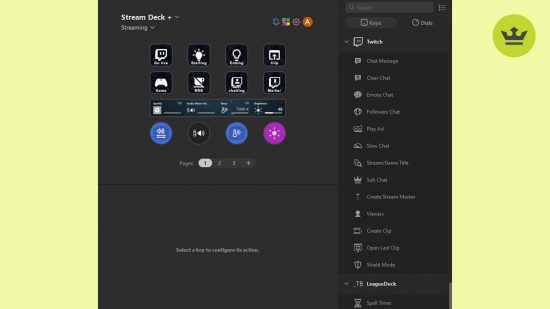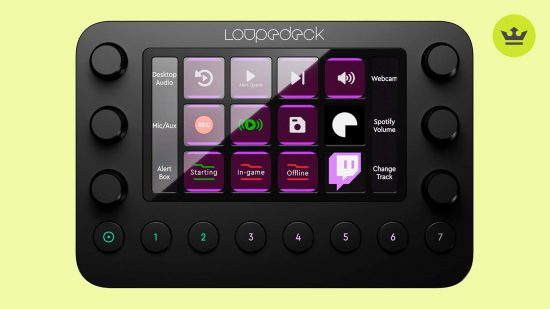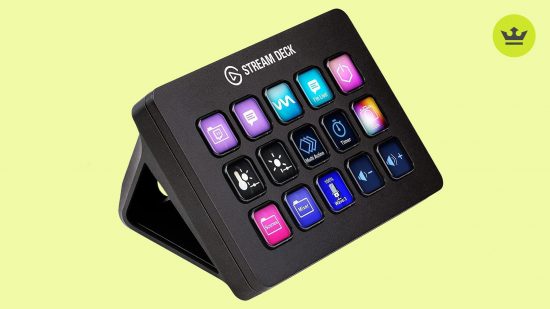Our Verdict
The Elgato Stream Deck + is a brilliant product for content creators and streamers. Its construction is solid, and the many tools available make it the perfect desktop accompaniment. However, it’s but a small step in innovation, with some confusing software omissions and functionality issues holding it back.
In my review of the Elgato Stream Deck +, I tested the latest addition to Elgato’s stream deck lineup. It’s a versatile tool that has proven to be a game-changer for creating live content and enhancing productivity in various digital activities.
Over the past several years, Elgato has consistently innovated in the streaming space, producing hardware – and accompanying software – that content creators the world over have clamored to get their hands on. From the best capture cards to key lights, and green screens to the best streaming cameras, the Corsair-owned brand has managed to establish itself as a market leader while staving off stiff competition from the likes of Logitech, Razer, and others.
The Stream Deck is an increasingly ubiquitous piece of tech that sits on the desks of most of the biggest streamers in the game, allowing them to switch scenes, tweak settings, and much more using the programmable keys every product in the lineup possesses. It’s also possible to trigger complex automation by assigning multiple actions to a single key, pushing what’s possible on broadcast while making engaging with their community a far more fluid experience – no more clicking around OBS. A device with dedicated macro keys isn’t a new invention, but Elgato has certainly helped popularize owning one.
By putting dynamic macros – powered by the intuitive Stream Deck software – at your disposal, Elgato has also created a powerful productivity tool. For example, I have a multi-action trigger on my trusty Stream Deck MK.1 – a point of reference for this review – that instantly opens all of the web pages I need to go about my day, a key for a Pomodoro timer that’s baked into the deck itself, and a couple of different profiles that will automatically pop up based on which program I’m working in (it’s especially handy for Adobe Photoshop since I don’t have all the keyboard shortcuts committed to memory). Surely I don’t need anything more? Elgato seems to think otherwise.
Having originally released back in November 2022, the Stream Deck + was initially praised for its potential. However, it ultimately lacked the software support to get the best out of its bells and whistles – its touch screen and dials. At the time, it was hard to vindicate its $200 price tag when for 50 bucks less you could get its little brother, the 15-key Stream Deck MK.2, which had a better use case for most. Now a year on, has the Stream Deck + cemented its place as the best stream deck? Or is it a device that you should avoid decking your streaming setup with? The answer is situational, so read on for my breakdown.
Pros
- Versatile all-in-one solution
- Excellent build quality
- Best-in-class software
- Wave Link makes it a great hardware mixer alternative
Cons
- Lack of haptics on the touch bar
- No in-built profiles for productivity apps
- Limited dial and touch bar support
- No adjustable stand
Specs
Elgato Stream Deck + specs:
| Connectivity | Wired, USB-A to USB-C |
| Buttons | 8x keys, 1x touch bar, and 4x dials |
| Platforms | Twitch, Twitter, XSplit, YouTube, Spotify (and many more) |
| Size | 5.4 x 5.5 x 4.3 inches |
Design
The Elgato Stream Deck + is the lankiest sibling in the Stream Deck family. I was pleased to find that it isn’t too large for the gap between my monitors and their stand. Handling it for the first time, I was impressed by how solid the build quality was, especially when it came to the textured metal dials. The main body itself is an all-plastic construction, though I am quietly confident it would easily survive the ~two-foot drop onto my carpet should I accidentally send it flying.
When it comes to the eight LCD keys that are nested just below the Stream Deck branding, there are a couple of small improvements to report over the other models. The Stream Deck + keys are 33% larger (I measured them as 20mm x 20mm) than those on my MK 1, and the LCDs not only render colors better than my MK.1 but the text is also much crisper. They’re still using the same membrane-based design as the other Stream Decks, finishing their descent with a tactile bump, but there is far less mushiness on the newer model. Granted, this could change with use over time, but for now, I’m impressed.
With that being said I also can’t help but feel a little disappointed, as I’m sure that Elgato could’ve popped a couple of extra keys into the Stream Deck +’s chassis with space to spare if it wanted to. Seeing the edges of the embossed strip that houses the dials aligning perfectly with the garishly chunky bezel surrounding the 4.2” x 0.5” LCD touchscreen, but not with the buttons themselves is low-key upsetting to look at. It’s a minor gripe, especially considering how much functionality you get from Stream Deck +’s unique inclusions. Still, Elgato doesn’t want you to have it all without shelling out for an accompanying deck.
Shifting down to the touchscreen itself, though it only comes in at a resolution of 800 x 100, the panel renders text beautifully, and as with the keys puts the legibility of my Stream Deck MK.1 to shame. The strip is more than bright enough to be seen in most day-to-day conditions, and you can easily tweak the brightness in the Stream Deck software if you find yourself flashbanged every time you shift between pages. I’ve already noted the inelegant bezels, but the fact that they’re squared off whereas the rest of the deck sports rounded corners at every opportunity is, again, a design inconsistency I turned my nose up at.
Towards the base of the Stream Deck + we have the four aforementioned rotary encoders. Each dial can be rotated 360 degrees both ways, offering an apt amount of resistance between intervals. They can also be pushed in with a pronounced and incredibly satisfying haptic click which means you won’t have to look at the panel to confirm you’ve input a command. This is incredibly useful if you’re trying to retain eye contact with your adoring audience while messing with your settings. Sadly, the touch bar didn’t quite get the memo, so I can’t award full marks for tactility here.
As we reach the base of the Stream Deck + I am once again left scratching my head as to why Elgato continues to insist on a static orientation for its current-gen Stream Deck stands, instead of the adjustable one packaged in with the original MK1 deck. The 45-degree slant is ideal for most streamers, but I would be far more inclined to use it for editing workloads if I could lay the device flat on my desk à la Loupedeck Live. You can unscrew the base of the deck, but with where the USB-C port is located on the back of the unit it’s impossible to do so even then – that is, unless you fancy suspending the deck over the side of your desk, or gouging a hole in it to allow the wire through.
The Stream Deck + comes in two colors – black and white. While you can’t customize its faceplate as you can with the Stream Deck MK.2, you can switch out the dials – Elgato currently stocks gold, silver, blue, pink, purple, and red. With that being said, there are plenty of third-party covers on sites like Etsy, alongside alternate dial colorways for those who want something a little more bespoke.
Features and Performance
One thing I am happy to see in the current generation of Elgato’s Stream Deck products – barring the Stream Deck Mini – is the shift to a removable 1.5m USB-C cable to power the device. It’s a basic quality-of-life improvement over the soldered connection on the MK.1, but it is worth noting.
Plugging the Stream Deck + in for the first time I was greeted with… nothing. The unit remained seemingly lifeless, and I feared that it had died in transit to me. However, once I loaded my Stream Deck software, I found that it was simply because I hadn’t assigned anything to the keys yet.
After loading it up with various functions, the membrane keys provide an instantaneous response when triggered. While I didn’t notice any real difference in speed when pitted against my MK.1’s keys, that’s simply because these products already perform excellently at their bread-and-butter function. There are however some foibles elsewhere.
Attempting to toggle a setting using the touch screen would sometimes trigger one of the other dials instead. At one point, the lights on one dial were getting flicked on and off as I repeatedly attempted to mute a program assigned to one at the other end of the deck. While my neighbors probably found the solo rave I was seemingly having in my office funny, I was less amused as I jabbed my finger at the panel in a futile attempt to restore order. Thankfully, this isn’t a consistent issue and the screen has behaved for the most part, but be sure to load up a drum ‘n’ bass playlist just in case things get a little… oontz oontz.
Dial stacking is also a hit-and-miss feature for me. The ability to cycle through multiple settings on a single rotary knob ensures that I can load everything I need to control my PC volume, microphone, and lighting from multiple sources simultaneously – I can’t qualm the functionality here, and the versatility is no joke. However, long press actions seem to be completely disabled when a function is put into a stack, as I could no longer turn my Key Light Air or Hue lights on or off once they were grouped up. This is fine if you want to pop them on using their apps before going live, but it’s a bizarre omission for sure.
Software
The approachability of Elgato’s Stream Deck software and its vast plugin library has historically been what sets the Stream Deck experience apart from its competition. Assigning functions – even multiple actions – to the deck is incredibly easy, requiring you only to drag and drop them onto the visualized version of your Stream Deck + interface. Keys can be customized using the litany of downloadable icons, and you can even label them with text. You can’t get as creative as you can with Loupedeck’s software, but it’s enough for my needs.
When you’re initially setting up your new Stream Deck +, you’ll spend much of your time browsing the recently revamped Elgato Marketplace. This used to exist within the Stream Deck software, but Elgato has now opened up a dedicated site from which you can download icons and other elements directly to your deck. Profiles need to be manually imported into the software from your PC once downloaded, however.
Here you’ll find crucial plugins to getting your stream ship shape, such as those from OBS, Twitch, and Voicemod, alongside various free and paid-for assets that you can use to amp up your production value. While the Stream Deck + doesn’t come with pre-configured profiles for major productivity apps like those in the Adobe suite – something the Loupedeck does – you can at least buy a third-party one for around $30 from the store. This is disappointing considering photo and video editing are core components of the modern streaming experience, so hopefully we’ll at least see some basic free-to-download alternatives from Elgato at some point.
Elsewhere in the store, there are some really fun tools that you can get hold of, such as a memory game and a magic eight ball. In constant search of dopamine, I downloaded a profile that turned my deck into a Tamagotchi, complete with the ability to feed it and put little hats on it – adorable. However, this was only configured to work with my Stream Deck MK.1 – a running theme for most profiles I took an interest in. Dedicated Stream Deck + support still feels like an afterthought in most cases, and third-party support for the product remains lacking.
One neat thing that Elgato has opened up to Stream Deck + is access to its Wave Link mixing software without having to own a Wave microphone. This effectively turns the deck into a hardware mixer akin to the GoXLR sans the XLR input, allowing you to get more from some of the other best streaming microphones out there. You can get a similar software experience through a mixture of Voicemeeter and OBS plugins if you don’t have any of these products, but Wave Link is far more intuitive. It’s not a selling point, but a welcomed extra.
Should you buy it?
- Yes: if you don’t have a physical audio mixer
- Yes: if you have other Elgato products like the Key Light and Streamcam
- Yes: if you don’t mind the fixed-angle stand
- No: if you’re looking to upgrade from an existing non-Mini Stream Deck
- No: if you’re not streaming or using productivity apps regularly
- No: if you’re an editor
If the Elgato Stream Deck + isn’t for you
Loupedeck Live: a customizable macro console that offers a similar experience to the Elgato Stream Deck +, but is perfect for editors thanks to its pre-configured profiles.
The Loupedeck Live may be a smidge more expensive than the Stream Deck +, but for those who engage in heavy editing workloads or desire more granularity over their macros, there isn’t a better product. The software could be better, though it has improved by leaps and bounds over the past few years.
Elgato Stream Deck MK.2: a 15-key Stream Deck from Elgato that is ideal for those who already have an audio mixer.
For $50 less than the Stream Deck + you can always opt for ol’ reliable, Stream Deck MK.2. If you don’t have a real need for dials and fancy touch bars to control your stream, then the bonus functionality from the extra keys is more than worth trimming down your expenditure for. Also, Tamagotchi profile /hj.
Verdict
Regardless of my qualms, the Stream Deck + is a solid device overall. It’s responsive, well-built, and provides iterative upgrades over the other members of its product family. However, after a year there are still only limited plugin and profile options for this model, so its touch screen and dials remain largely luxury additions. At $200, this makes it hard to recommend to those who are looking to upgrade from a Stream Deck that’s larger than the Mini, or a physical mixer that already controls their stream audio – it’s overkill, otherwise.
